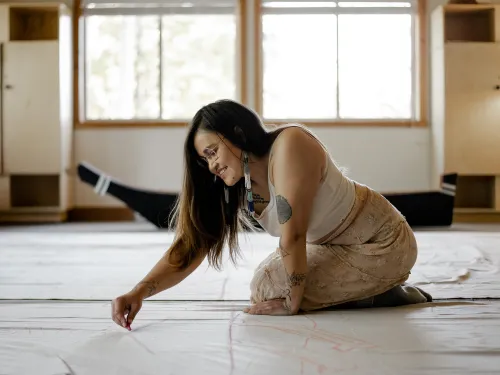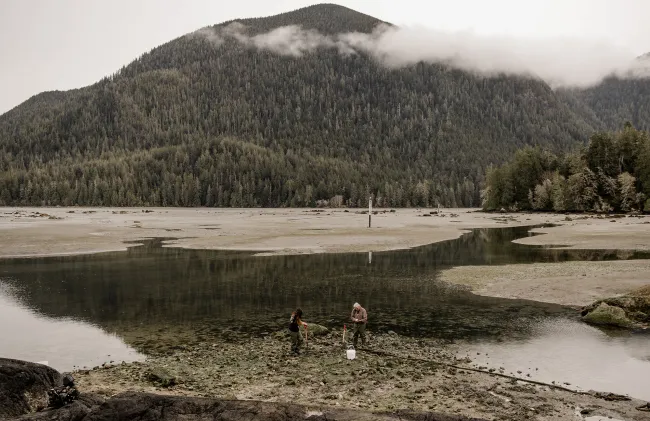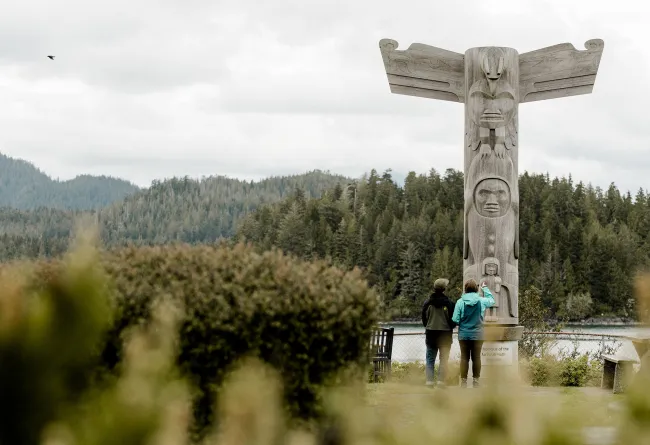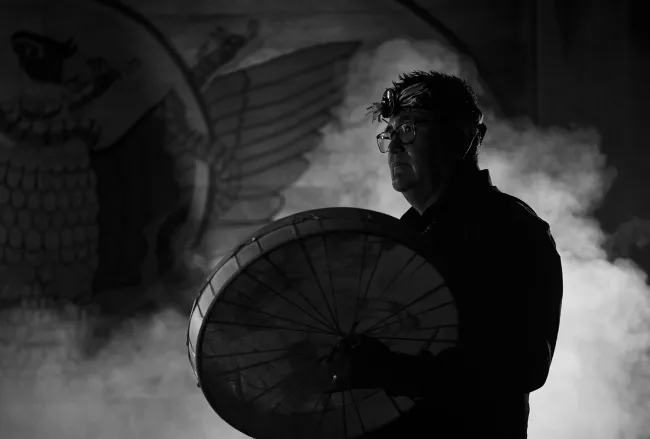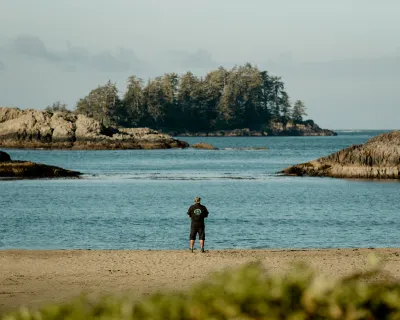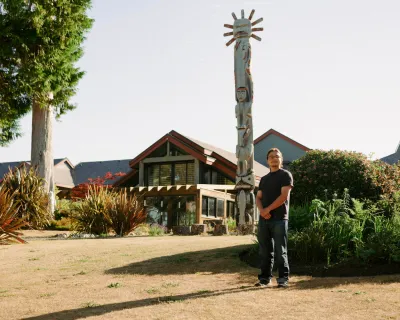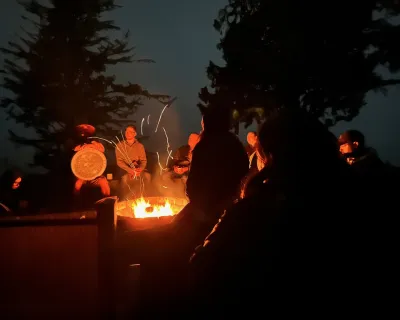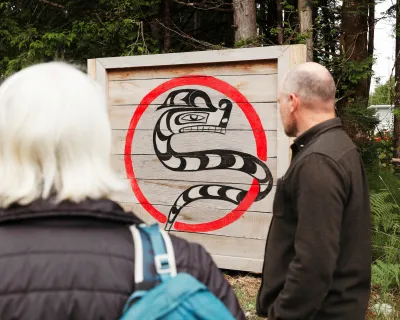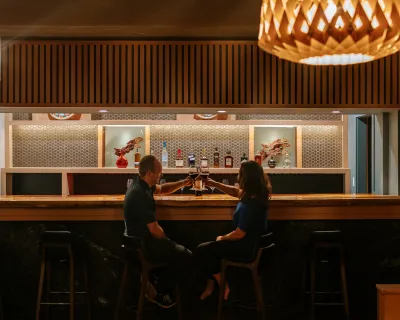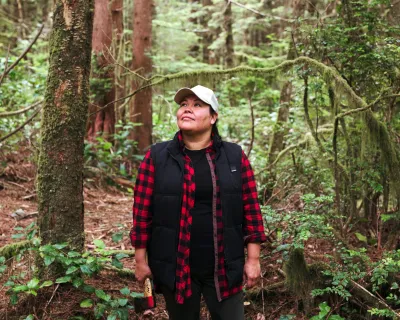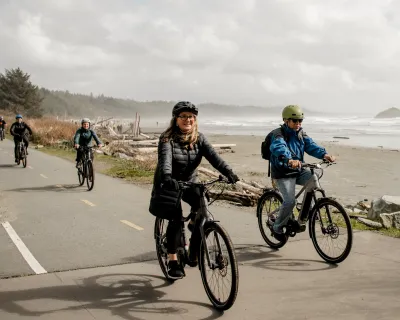THE COLOURS OF naaʔuu: IVY CARGILL-MARTIN PROFILE
Ivy Cargill-Martin is a Tla-o-qui-aht multidisciplinary artist, as well as the art director of the naaʔuu experience.
naaʔuu will be returning for it’s second year to the Tla-o-qui-aht owned Best Western Plus Tin Wis Resort in Tofino, BC on May 24th. naaʔuu means "to feast" and for those attending the three hour immersive evening will do just that.
naaʔuu is an opportunity to learn and celebrate Tla-o-qui-aht culture through traditional song, dance, food and art.
Cargill-Martin will be bringing to life large scale Tla-o-qui-aht curtains that will be on display in the Tin Wis Conference Center, one of the many highlights of the naaʔuu evenings.
Traditionally, curtains have played an important role in story telling for First Nations on Vancouver Island. Following the Indian Act in 1885, family crest and stories that were once painted directly on the wood in homes were translated onto curtains as a way for families to share their stories at gatherings and potlatches without getting caught.
At naaʔuu Ivy hopes the curtains she is designing and painting will help bring understanding of the of spoken stories full circle.
Cargill-Martin explains, “my goal here is to have a really good point of reference for the storyteller to help tell the story… hopefully inspire the people visiting our territory to learn more about the territory.”
Martin was raised on a float house tucked on the waters near Tofino, her father is a carver and her mother also an artist, it is only natural that Cargill-Martin pulls her inspiration from the land, nature, and her family. Martin says, “growing up on the float house, I didn't have TV. We didn't have electricity, none of that. It was just listening to the radio and doing art. The majority of the time I would kind of just do whatever my mom was doing, so she would be crocheting and I'd start crocheting, she'd be making necklaces and I'd make a necklace.”
“It's definitely our way of storytelling and keeping traditions alive in a sense, there was no written information… the totem poles tell a story, our family curtain tells a story. Being able to do these curtains is fun because now I get to tell a story too” Cargill-Martin explains.
The large curtains at naaʔuu will be Ivy’s largest visual instalment yet.
Cargill-Martin’s curtains will share the stories, history, and culture of the Tla-o-qui-aht First Nation people. Each scene, each colour pulling on the importance of their traditions. Martin explains “I was always told that our traditional main colours are red, black and white and that was because traditionally we took inspiration from the land. Out here we've got orcas that are black and white. We've got whales that are black and white. We've got wolves that are black and white, and we get the red from the wolves as well.”
Finding traditional Tla-o-qui-aht First Nation art can be challenging, making naaʔuu a unique experience to dive into the Indigenous art in Tofino and Cargill-Martin explains why, “more or less a majority of it is either overseas or was burnt or destroyed. I think part of the reason it isn't really featured as much is because there wasn't really much to be featured. Majority of the totem poles were either cut down and sent to museums or burnt. So by doing this and showcasing it, it'll be a really awesome way for people to experience good art and culture and probably actually get to know about it a little bit more.
If you are looking for more Indigenous art in Tofino there are easily accessible places to see more. Starting on the way to Tofino, at the top of the Sutton Pass on Highway 4, there is a carved Welcome sign. As you make your way to Tofino, along the highway there is a thunderbird totem at Wally Creek.
Once you get to Tofino you can head to the village green to see the Weeping Women carving and at Anchor Park where there is a thunderbird totem.
The newest attraction would be the art gallery at the Tla-o-qui-aht owned Tsawaak RV Resort, featuring unique pieces from a variety of Vancouver Island Indigenous artists, selling pieces you can take home with you.
Lastly, the most immersive experience is naaʔuu.
Get your tickets now
When May & June, 2024
May 24 & 25
June 7, 8, 14, 15, 22, 28 & 29
Fridays and Saturdays, 6 - 9pm
When you Go
The Tin Wis Resort is a Tla-o-qui-aht First Nation-owned beachfront hotel located in Tofino (within Tla-o-qui-aht First Nation’s homelands) located on the West Coast of Vancouver Island.
getting there
access to Tofino is a BC Ferries adventure away from Vancouver or direct flight from YVR with Pacific Coastal Airlines.
where to stay
Best Western Plus Tin Wis Resort (Tla-o-qui-aht owned and operated) is offering a naaʔuu packaged stay, with discounts on your event tickets with a hotel booking. To book, go to the Best Western Tin Wis site, and select your naaʔuu dates to find the best offers.
Tsawaak RV Resort & Campground is for the nature lovers who want to stay outdoors or bring your own accommodations. Situated right next to Tin Wis Resort, and also operated by the Tla-o-qui-aht First Nation. Phone the resort at 250-266-5015 to book your naaʔuu package directly.
Tofino Resort & Marina is offering 15% off for guests booking their naaʔuu package
Pacific Sands Beach Resort is offering 10% off of the ticket price for guests booking their cultural package
Learn more about naaʔuu through this Vancouver Sun review.
Tla-o-qui-aht legacy of nature preservation
Tla-o-qui-aht First Nation is Canada’s most storied First Nations, home to a ground-breaking Indigenous lands rights settlement after one of the country’s biggest civil uprisings, known as “the war in the woods.”
READ MORE ON NAAʔUU
Get more detail about the experience and how you can enrich your visit.
